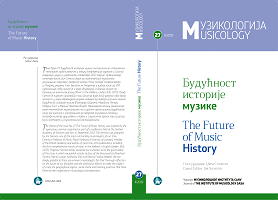Ангажман у музичкој критици: написи Павла Стефановића у Музичком гласнику (1938–1940)
Engagement in musical criticism: Pavle Stefanović’s textsin the Music Herald (1938–1940)
Author(s): Aleksandar VasićSubject(s): Cultural history, Music, Social history, Sociology of Art
Published by: Muzikološki institut SANU
Keywords: Pavle Stefanović; Music Herald (1928–1941); Serbian twentieth-century music criticism; Serbian twentieth-century music periodicals; engagement in music criticism; antifascism;
Summary/Abstract: Pavle Stefanović (1901–1985) is one of the most prominent Serbian music critics and essayists. He created extensive musicographic work, largely scattered in periodicals. A philosopher by education, he had an excellent knowledge of music and its history. His style was marked by eloquence, associativity and plasticity of expression. Between 1938 and 1940 he published eighteen music reviews in T e Music Herald, the longest-running Belgrade music magazine in the interwar period (1928–1941, with interruption from 1934 to 1938). Stefanović wrote about concerts, opera and ballet performances in Belgrade, performances by local and eminent foreign artists. His reviews include Magda Tagliaferro, Nathan Milstein, Jacques T ibaud, Enrico Mainardi, Bronisław Huberman, Alexander Uninsky, Alexaner Borovsky, Ignaz Friedman, Nikita Magalof and many other eminent musicians. T is study is devoted to the analysis of the Stefanović’s procedure. Pavle Stefanović was an anti-fascist and lef ist. He believed that the task of a music critic was not merely to analyze and evaluate musical works and musical interpretations. He argued that the critic should engage in important social issues that concerned music and music life. T at is why he wrote articles on the occasion of German artists visiting Belgrade, about the persecution of musicians of Jewish descent and the cultural situation in the T ird Reich. On the other hand, Stefanović was an aesthetic hedonist who expressed a great sense of the beauty of musical works. T at duality – a socially engaged intellectual and a subtle „enjoyer” of the art – remained undisturbed. In these articles he did not go into a deterministic interpretation of the structure of musical composition and the history of music. And he did not accept the larpurlartistic views.
Journal: Muzikologija
- Issue Year: 2/2019
- Issue No: 27
- Page Range: 203-220
- Page Count: 18
- Language: Serbian

